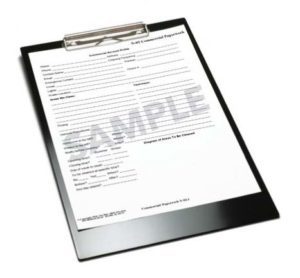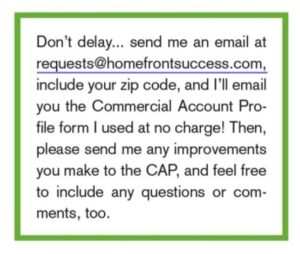The Regular Commercial Account Profile

By Steve Toburen
All cleaning and restoration contractors crave stable cash flow that they can depend on. And nothing provides that wonderful, consistent flow of cash into your business better than regular contract commercial accounts.
For most carpet cleaners, residential work falls off dramatically with the mud and snow winter brings. But regular, contract commercial accounts keep a company’s technicians busy and the bills paid… all year long! Plus, the employees of these commercial accounts are a captive marketing audience for residential work.
Restoration businesses also enjoy the consistent cash flow of commercial work for “evening out” the lows between those big losses. And even better, when your restoration company is an ongoing presence with a commercial or institutional account, who will be first in line when their pipes break or a smoke loss occurs?
Of course, few good things in life come easily.
Your challenges
Hands down, the biggest challenge in acquiring commercial work is… us! Most of us (me included) suffer from the dreaded fear of rejection. Translation: We hate selling. So, we invent what I call “displacement activities” that keep us busy, busy, busy with more enjoyable stuff.
Hopefully, you’ve conquered your fear of selling and have at least one dedicated sales morning in which you contact 15-20 new prospective clients every week. The Commercial Carpet Analysis form (See it in the May/June 2018 issue of Cleanfax.) will be a huge help in structuring these sales calls.
If you consistently make these weekly dedicated sales calls, you will sign up new commercial accounts. But now you must consistently produce the work — not “you” personally. Remember that your “highest and best use” is not running a wand at 3:00 a.m. You’ll likely hire (probably) part-time employees.
The one thing regular commercial accounts demand is consistency, and most employees have a pesky habit of getting sick, hurt, and/or quitting, often with zero notice and at the worst times! If the only person who knows this account is your suddenly MIA employee, you have a problem. (I found this one out the hard way!)
Steve’s solution
I recognized, rewarded, and appreciated my workers, but I never wanted to need any certain employee more than they needed me. This delicate situation inevitably led to me being “held hostage” by the employee.
 A complete business infrastructure built on interlocking written (and enforced) systems, procedures, and forms is how you avoid being held hostage by your workers. This business infrastructure helped my company avoid problems and also cut 40 points off my high blood pressure.
A complete business infrastructure built on interlocking written (and enforced) systems, procedures, and forms is how you avoid being held hostage by your workers. This business infrastructure helped my company avoid problems and also cut 40 points off my high blood pressure.
An essential part of my “commercial infrastructure” was my Commercial Account Profile (CAP) form.
This form reminded us to get important job details we would otherwise forget and let us file them all in one place (not just in an employee’s often faulty memory).
My CAP form included everything from emergency contacts, to how and when we would clean the building and what equipment to bring. The CAP also included:
- Where the lights and breakers were and what lights to leave on,
- Locations for water filling and dumping,
- “Open access” instructions (keys and alarm codes),
- Security procedures, including other workers on the premises during cleaning,
- Areas to be cleaned and frequency for each “zone” (including color-coded floor plans),
- Air movers to be left and when to pick them up,
- When to clean (day of week and time).
And the list went on and on. Sure, this is “just more paperwork.” But if you ever hope to build a critical mass business that will run smoothly without you, then it must be built on systems and procedures.
The result
The Commercial Account Profile form brought many advantages to my company:
- A structured, follow-up interview: After signing off on our service agreement (contract) with a new account, my sales rep would bring out a clipboard with the CAP form and request a “walkthrough tour.” Then he or she would jot down the contact’s answers. This created a great initial impression of us as a very organized company.
- Smoother scheduling: When the filled-out CAP form arrived back at our office, my operations manager had all the job information at her fingertips. She literally could schedule the job out years ahead and then build other work around it.
- More flexible production with “interchangeable” employees: If the regular employee for the account was not available, it was no problem. We just scheduled a different employee to do the work. Even if the new, on-the-job tech had never seen the work before, they just reviewed the CAP included in the job folder and checked for special, one-time details on their Production Day Sheet (more on this in the Jan/Feb 2018 issue of Cleanfax).
- You shouldn’t be “indispensable” either: I see far too many cleaning and restoration companies flounder and fail when the owner is suddenly incapacitated. Don’t let this happen to your family and employees. They (and you) deserve to have your business continue onward without you.
Even if you just are starting out building regular commercial accounts, please implement this Commercial Account Profile form. Remember, every critical mass business (including mine) started with the first step.
Steve Toburen started and ran a world-class cleaning and restoration firm for over 20 years. He is now the director of training for Jon-Don’s Strategies for Success program, which includes a complete, turn-key business infrastructure for cleaning and restoration companies. Toburen also founded HomeFrontSuccess.com, a resource portal with training programs for contractors working in customer’s homes. Reach him at [email protected].












